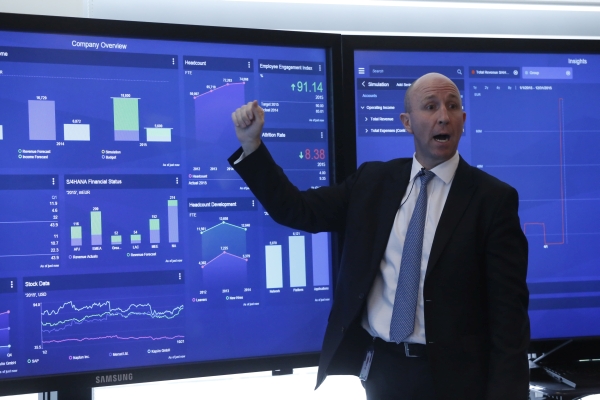Published on the 28/10/2015 | Written by Donovan Jackson

While companies have generally focused digitisation efforts on line of business processes, there is one rather significant level to which automation hasn’t yet reached: the boardroom…
To this day, in preparation for a board meeting, directors are required to assemble heroic quantities of paperwork, entering the chamber armed with same. That preparation can take weeks and, as is the case with all data contained on paper, the information is effectively trapped.
Not any more, as SAP ushers in the era of the digital boardroom. The German ERP company (which is working very hard to show that it is not just an ERP company) threw the covers off the digital boardroom at an exclusive demonstration to the press at its recent APJ Media Summit in Singapore.
Taking charge of the demo was Scott Russell, SAP APJ chief operations officer (pictured). With an example of the digital boardroom set up for the benefit of the assembled scribes, replete with the typical directors who would attend a board meeting, the scene was dominated by three 50-inch touchscreens. “The digital boardroom can be anything you want it to be. It connects people, places and information, facilitates internal and external data presentation, provides contextualisation and takes out the paper,” said Russell.
That was quickly shown, with the typical facts and figures presented on the screens. Russell noted that when queries are made of directors, the most frequent answer given is ‘That’s a good question. I’ll come back to you’. The digital boardroom renders that notion obsolete. Drawing on real time operational information, the numbers are presented as they are in reality, rather than point-in-time snapshot contained in paper documents.
Scenarios can be played out on the spot, drawing on actual company data; in the demonstration Russell demonstrated likely outcomes should, for example, additional people be hired into a specific region which has a quantified sales pipeline.
The digital boardroom draws on the concept of the real time digital dashboard familiar to business intelligence users, but, said Russell, it is introduced to facilitate board meetings for the first time. “It has come out of an internal discussion and dialogue around how the [SAP] board makes decisions.
Directors will often argue for a decision based on their point of view, and will prepare information to justify that point of view. Board papers typically represent a combination of the views of directors; what [SAP’s] board wanted was transparency, instead of guesswork, so that directors can make unbiased decisions based on ‘true’ information.”
The digital boardroom, which is in use by SAP itself, was introduced as a concept at the company’s Sapphire conference which took place in Orlando in May this year, and launched as a product in the very week in which Russell was demonstrating it. “The product is pretty brand new,” he confirmed, and while a number of clients have been engaged on it, no sales have been made as yet.
The underpinnings of the SAP digital boardroom also mean the sales pipeline is highly qualified: it is built on SAP’s Cloud for Analytics, draws on line-of-business data from the S/4HANA suite and mashes data in the HANA Cloud Platform. That means only those clients which are using these solutions are candidates for the digital boardroom, Russell confirmed. The vendor said it has 1300 customers on S/4HANA, the most recent iteration of its ERP solution (which is built on a different code base to its R/3 solution), out of a total of 296 000 customers worldwide. S/4HANA launched early in 2015.
While Russell conceded that change to boardroom processes and traditions is unlikely to be easy, he added, “We believe this will enable better decision-making, and [owing to digitisation] pre- and post-board meetings, there is a lot of activity that will no longer be required.”
Asked about ‘takeaways’, or information which is provided to or left with directors after a meeting, Russell said that hadn’t yet been considered, but was something to think about as a mechanism to give directors the opportunity to reflect and ruminate on information shared during the meeting, but at their own convenience.
“What the digital boardroom does is to take the guesswork out of decision making. It moves the conversation from ‘I think this is the answer’ to ‘this is the answer, and here’s the data to back it’. It changes the way the board operates by freeing [directors] from wasting time pulling information together,” he concluded.
SAP said the advantages of the digital boardroom include:
- Transparency: Standards-based reporting on financials, operations, marketing and sales are based on a single source of the truth, delivered in real time, with no data duplication.
- Instant data-driven insights: Analytical exploration functions address ad hoc questioning and support decision-making.
- Simplified processes: The user interface enables natural interactions based on a single-screen experience. It is delivered through a touch-screen experience, whether using a projector, a laptop or wearable device. Visualisations of live data eliminate static presentations. Collaboration features assign and track action items even outside of scheduled meetings.
Donovan Jackson attended the SAP APJ media tour as a guest of SAP.



























